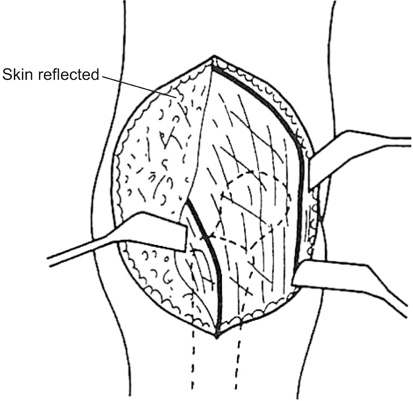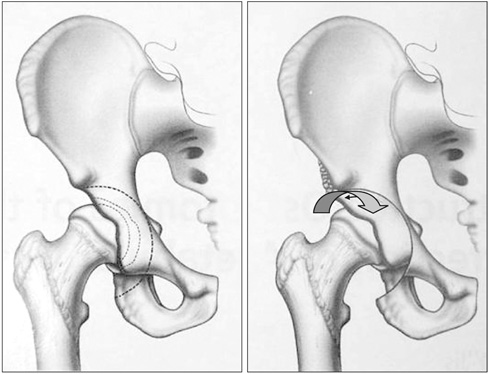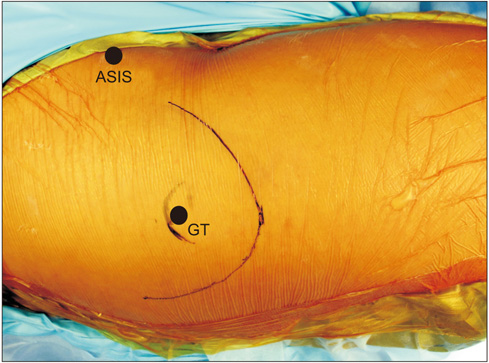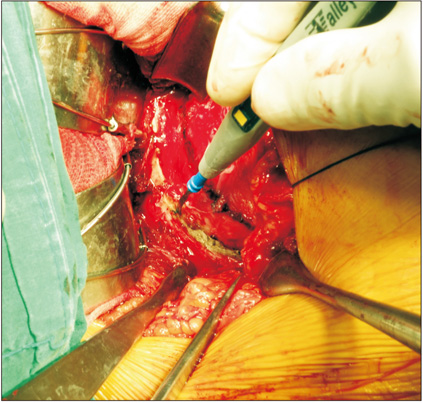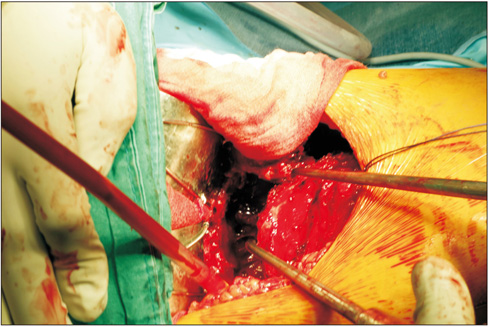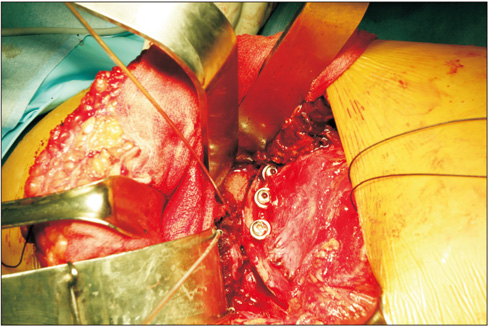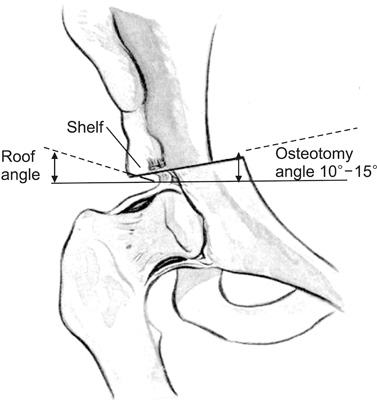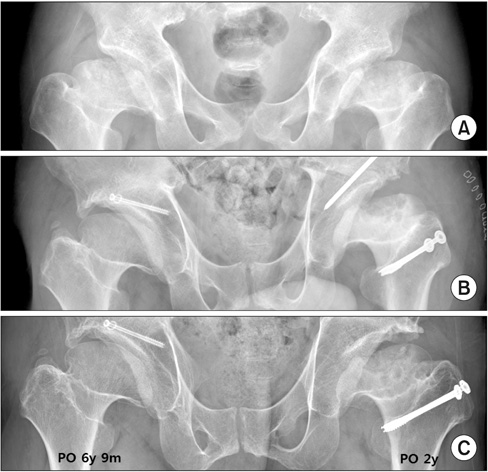J Korean Orthop Assoc.
2017 Dec;52(6):500-513. 10.4055/jkoa.2017.52.6.500.
Pelvic Osteotomy in Adults
- Affiliations
-
- 1Department of Orthopaedic Surgery, College of Medicine, Kyung Hee University, Seoul, Korea. yjcho@khmc.or.kr
- KMID: 2421343
- DOI: http://doi.org/10.4055/jkoa.2017.52.6.500
Abstract
- Pelvic osteotomy is a surgery for correcting acetabular deformity, which causes incomplete coverage of the femoral head or biomechanically abnormal load to the hip joint. Pelvic osteotomy can be divided into two categories: reconstructive or realignment osteotomy and salvage osteotomy. Reconstructive osteotomy can be performed to correct the dysplastic hip with good congruency, and include most pelvic osteotomies, except Chiari osteotomy. Among these, Bernese osteotomy, rotational acetabular osteotomy, and periacetabular rotational osteotomy are commonly being used. Salvage osteotomy, which include Chiari osteotomy only, can be performed to increase the coverage of the femoral head of hip joint with joint incongruency due to the severely deformed femoral head and acetabulum or advanced osteoarthritis. Chiari osteotomy is a kind of arthroplasty reducing the pressure applied to the head, and increasing the bone coverage on the upper part of the femoral head. It is effective in reducing hip pain and slowing degenerative changes; however, as the surface is covered by fibrous cartilage, it is vulnerable to degenerative changes. The pelvic osteotomy is a very important and useful surgical technique to preserve joints, despite being a difficult procedure that is technically demanding.
Keyword
MeSH Terms
Figure
Reference
-
1. Solomon L, Schnitzler CM. Pathogenetic types of coxarthrosis and implications for treatment. Arch Orthop Trauma Surg. 1983; 101:259–261.
Article2. Stulberg SD. Unrecognized childhood hip disease: a major cause of idiopathic osteoarthritis of the hip. In : Cordell LD, Harris WH, Ramsey PL, MacEwen GD, editors. The hip: Proceedings of the Third Open Scientific Meeting of the Hip Society. St. Louis (MO): CV Mosby;1975. p. 212–228.3. Cooperman DR, Wallensten R, Stulberg SD. Post-reduction avascular necrosis in congenital dislocation of the hip. J Bone Joint Surg Am. 1980; 62:247–258.
Article4. Cooperman DR, Wallensten R, Stulberg SD. Acetabular dysplasia in the adult. Clin Orthop Relat Res. 1983; (175):79–85.
Article5. Klaue K, Durnin CW, Ganz R. The acetabular rim syndrome. A clinical presentation of dysplasia of the hip. J Bone Joint Surg Br. 1991; 73:423–429.
Article6. Dorrell JH, Catterall A. The torn acetabular labrum. J Bone Joint Surg Br. 1986; 68:400–403.
Article7. Harris WH. Etiology of osteoarthritis of the hip. Clin Orthop Relat Res. 1986; (213):20–33.8. Millis MB, Murphy SB, Poss R. Osteotomies about the hip for the prevention and treatment of osteoarthrosis. J Bone Joint Surg. 1995; 77:626–647.
Article9. Ninomiya S, Tagawa H. Rotational acetabular osteotomy for the dysplastic hip. J Bone Joint Surg Am. 1984; 66:430–436.
Article10. Hasegawa Y, Iwase T, Kitamura S, Yamauchi Ki K, Sakano S, Iwata H. Eccentric rotational acetabular osteotomy for acetabular dysplasia: follow-up of one hundred and thirty-two hips for five to ten years. J Bone Joint Surg Am. 2002; 84:404–410.11. Kim HJ, Kim JW. Acetabular osteotomy. J Korean Hip Soc. 2004; 16:254–260.12. Ko JY, Wang CJ, Lin CF, Shih CH. Periacetabular osteotomy through a modified ollier transtrochanteric approach for treatment of painful dysplastic hips. J Bone Joint Surg Am. 2002; 84:1594–1604.
Article13. Nakamura S, Ninomiya S, Takatori Y, Morimoto S, Umeyama T. Long-term outcome of rotational acetabular osteotomy: 145 hips followed for 10-23 years. Acta Orthop Scand. 1998; 69:259–265.
Article14. Yasunaga Y, Ochi M, Terayama H, Tanaka R, Yamasaki T, Ishii Y. Rotational acetabular osteotomy for advanced osteoarthritis secondary to dysplasia of the hip. J Bone Joint Surg Am. 2006; 88:1915–1919.
Article15. Kang CS. Rotational acetabular osteotomy in acetabular dysplasia. J Korean Hip Soc. 2001; 13:208–213.
Article16. Kang CS, Shon SW, Kim SY. Rotational acetabular osteotomy for the dysplastic acetabulum. J Korean Orthop Assoc. 1986; 21:791–798.
Article17. Min BW, Bae KC, Kang CH, Song KS, Sohn SW. Rotational acetabular osteotomy for the dysplastic hip: a follow-up for 5 to 18 years. J Korean Orthop Assoc. 2005; 40:712–722.
Article18. Yoo MC, Cho YJ, Kim KI, Park HC, Jung CJ. Periacetabular rotational osteotomy in hip dysplasia: short term follow up result. J Korean Orthop Assoc. 2005; 40:434–441.
Article19. Hasegawa Y, Iwase T, Kitamura S, Kawasaki M, Yamaguchi J. Eccentric rotational acetabular osteotomy for acetabular dysplasia and osteoarthritis: follow-up at a mean duration of twenty years. J Bone Joint Surg Am. 2014; 96:1975–1982.20. Yasunaga Y, Fujii J, Tanaka R, et al. Rotational acetabular osteotomy. Clin Orthop Surg. 2017; 9:129–135.
Article21. Yasunaga Y, Takahashi K, Ochi M, et al. Rotational acetabular osteotomy in patients forty-six years of age or older: comparison with younger patients. J Bone Joint Surg Am. 2003; 85:266–272.22. Chang JS, Park JH, Park HG, Lee SH, Kim YK. Bernese periacetabular osteotomy for the hip dysplasia. J Korean Hip Soc. 1998; 10:141–148.23. Chang JS, Kwon KD, Shon HC. Bernese periacetbular osteotomy using dual approaches for hip dysplasia. J Korean Orthop Assoc. 2002; 37:226–232.24. Hussell JG, Rodriguez JA, Ganz R. Technical complications of the Bernese periacetabular osteotomy. Clin Orthop Relat Res. 1999; (363):81–92.
Article25. Myers SR, Eijer H, Ganz R. Anterior femoroacetabular impingement after periacetabular osteotomy. Clin Orthop Relat Res. 1999; (363):93–99.
Article26. Siebenrock KA, Leunig M, Ganz R. Periacetabular osteotomy: the Bernese experience. Instr Course Lect. 2001; 50:239–245.
Article27. Siebenrock KA, Schöll E, Lottenbach M, Ganz R. Bernese periacetabular osteotomy. Clin Orthop Relat Res. 1999; (363):9–20.
Article28. Steppacher SD, Tannast M, Ganz R, Siebenrock KA. Mean 20-year followup of Bernese periacetabular osteotomy. Clin Orthop Relat Res. 2008; 466:1633–1644.
Article29. Chiari K. Results of pelvic osteotomy as of the shelf method acetabular roof plastic. Z Orthop Ihre Grenzgeb. 1955; 87:14–26.30. White RE Jr, Sherman FC. The hip-shelf procedure. A long-term evaluation. J Bone Joint Surg Am. 1980; 62:928–932.
Article31. Park YS. Chiari pelvic osteotomy. J Korean Hip Soc. 2001; 13:214–216.32. Graham S, Westin GW, Dawson E, Oppenheim WL. The Chiari osteotomy. A review of 58 cases. Clin Orthop Relat Res. 1986; (208):249–258.33. Kawamura B, Hosono S, Yokogushi K. Dome osteotomy of the pelvis. In : Tachdjian MO, editor. Congenital dislocation of the hip. New York: Churchill-Livingstone;1982. p. 609–623.34. Matsuno T, Ichioka Y, Kaneda K. Modified Chiari pelvic osteotomy: a long-term follow-up study. J Bone Joint Surg Am. 1992; 74:470–478.35. Chiari K. Medial displacement osteotomy of the pelvis. Clin Orthop Relat Res. 1974; (98):55–71.
Article36. Anwar MM, Sugano N, Matsui M, Takaoka K, Ono K. Dome osteotomy of the pelvis for osteoarthritis secondary to hip dysplasia. An over five-year follow-up study. J Bone Joint Surg Br. 1993; 75:222–227.
Article37. Nakata K, Masuhara K, Sugano N, Sakai T, Haraguchi K, Ohzono K. Dome (modified Chiari) pelvic osteotomy: 10- to 18-year followup study. Clin Orthop Relat Res. 2001; (389):102–112.38. Kotz R, Chiari C, Hofstaetter JG, Lunzer A, Peloschek P. Long-term experience with Chiari's osteotomy. Clin Orthop Relat Res. 2009; 467:2215–2220.
Article
- Full Text Links
- Actions
-
Cited
- CITED
-
- Close
- Share
- Similar articles
-
- The Use of Xenograft ( Lubboc(r)) for Pelvic Osteotomy in Children
- Osteotomies Around the Hip Joint
- Triple Osteotomy of the Innominate Bone: Experlence with an adult Paralytie Hip
- Chiari Pelvic Osteotomy in Children and Adolescent
- 20-Year-Follow up of Treatment Using Spine Osteotomy and Halo-pelvic Traction for Tuberculous Kyphosis: A Case Report

